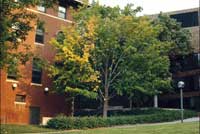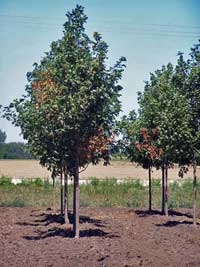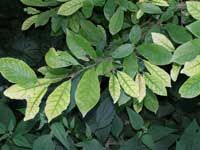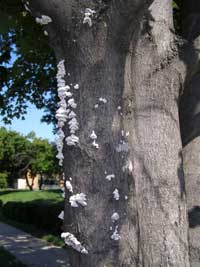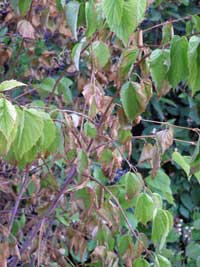Extension > Garden > Diagnose a problem > What's wrong with my plant? > Deciduous > Catalpa > Leaves discolored yellow to brown
Catalpa > Leaves > Leaves discolored yellow to brown
1 of 4
Verticillium wilt
Verticillium dahliae and V. albo-atrum
- Leaves are small and yellowed in chronic infections
- Leaves wilt, eventually turn brown and die in severe infections
- Leaf symptoms are often seen on only one or a few random branches in the canopy
- Dark olive to gray streaks are often visible in the sapwood if the bark is peeled back, appearing as rings or arcs in a cross section
- Symptoms may develop over a single season, or over several years
- More information on Verticillium wilt
2 of 4
Iron chlorosis
- Leaves yellow with green veins
- Most severe on branch tips or new growth
- Affected trees have poor growth, undersized leaves
- Symptoms occur on Catalpas in alkaline soils
- More information on Iron chlorosis
3 of 4
Sapwood rot
Schizophyllum commune
- Dead branches within the canopy
- Yellowing to brown leaves may be present
- Groups or rows of small (< 2 inches wide) semi-circle shelf fungi along killed branches or on the main trunk, often near cracks or wounds
- Schizophyllum shelf fungi are white and appear fuzzy on top
- Wood below fungal shelves is yellowish to white, spongy, crumbly and decayed
- Bark around fungal shelves dies and often falls off
- Common on trees stressed by drought, winter injury, wounds, mechanical injury or other factors
4 of 4
Armillaria root rot
Armillaria spp.
- Infected trees have poor growth, dead branches in the upper canopy, undersized and/or yellow leaves
- Flat white sheets of fungal growth (mycelial fans) between the bark and sapwood at the base of infected trees
- Thick black, shoestring-like fungus can sometimes be seen under the bark, around roots and in the soil around the base of the tree
- Wood is decayed, white, soft and spongy; this may extend from the base of the tree well up into the trunk
- Trees frequently break or fall over in storms
- Clusters of honey-colored mushrooms may grow at the base of the tree in fall
- More information on Armillaria root rot



